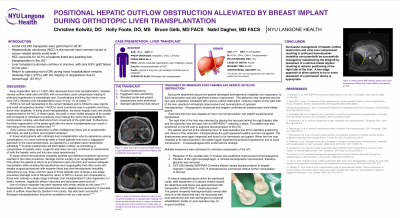General Surgery
Positional hepatic outflow obstruction alleviated by breast implant during orthotopic liver transplantation

Has Audio
Introduction/Purpose: The purpose of this case report is to describe a technique to alleviate hepatic outflow obstruction during a deceased donor orthotopic liver transplantation, caused by compression of the retrohepatic IVC when the liver was released to its position of rest. This technique utilizes a traditional silicone breast implant placed deep to the liver to elevate the liver off of the retroperitoneum, preventing compression of the IVC.
Methods or Case Description: This case describes a 66 year-old male patient with cirrhosis and liver failure secondary to hepatitis C infection, complicated by hepatocellular carcinoma which was minimally responsive to Yittrium-90 radioablation. The patient underwent a successful deceased donor liver transplant, however, was found to have hepatic outflow obstruction causing hemodynamic instability and decompensation prior to leaving the operating room. In order to take the patient to the ICU, laparotomy pads were placed behind the liver to elevated it away from the IVC, and the patient was left with an open abdomen. Upon return to the OR 48hours later, the lap pads were removed and replaced with a silicone breast implant.
Outcomes: This technique improved the venous outflow obstruction and prevented hemodynamic instability and decompensation, allowing the patient to leave the hospital in good condition.
Conclusion: Although an off label use, breast implants are readily available at most institutions, and an acceptable and effective way to help position a transplanted liver and alleviate venous outflow obstruction.
Methods or Case Description: This case describes a 66 year-old male patient with cirrhosis and liver failure secondary to hepatitis C infection, complicated by hepatocellular carcinoma which was minimally responsive to Yittrium-90 radioablation. The patient underwent a successful deceased donor liver transplant, however, was found to have hepatic outflow obstruction causing hemodynamic instability and decompensation prior to leaving the operating room. In order to take the patient to the ICU, laparotomy pads were placed behind the liver to elevated it away from the IVC, and the patient was left with an open abdomen. Upon return to the OR 48hours later, the lap pads were removed and replaced with a silicone breast implant.
Outcomes: This technique improved the venous outflow obstruction and prevented hemodynamic instability and decompensation, allowing the patient to leave the hospital in good condition.
Conclusion: Although an off label use, breast implants are readily available at most institutions, and an acceptable and effective way to help position a transplanted liver and alleviate venous outflow obstruction.

Christine E. Kolwitz, DO
Surgical Resident
NYU Winthrop
NYU Winthrop Hospital - NYU Langone Health
Astoria, New York, United States
